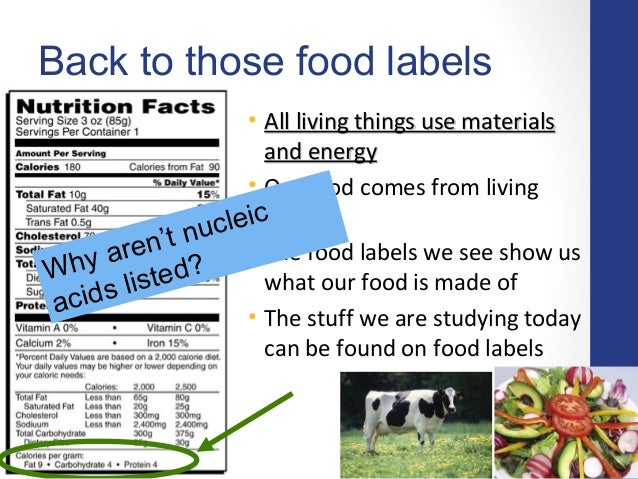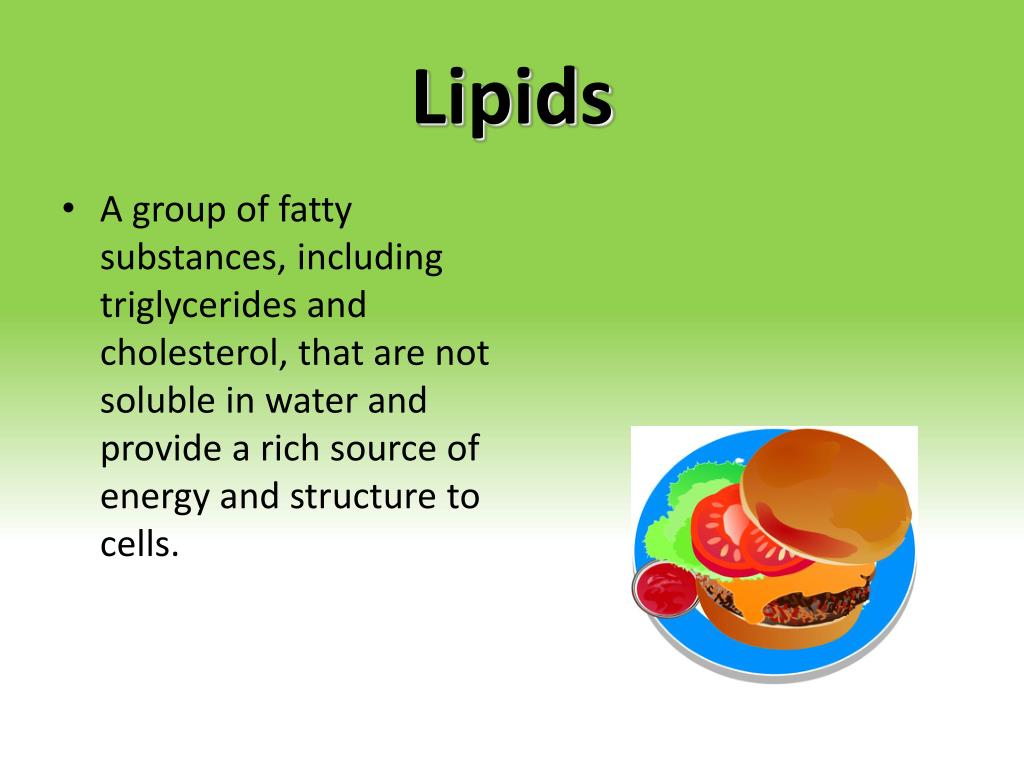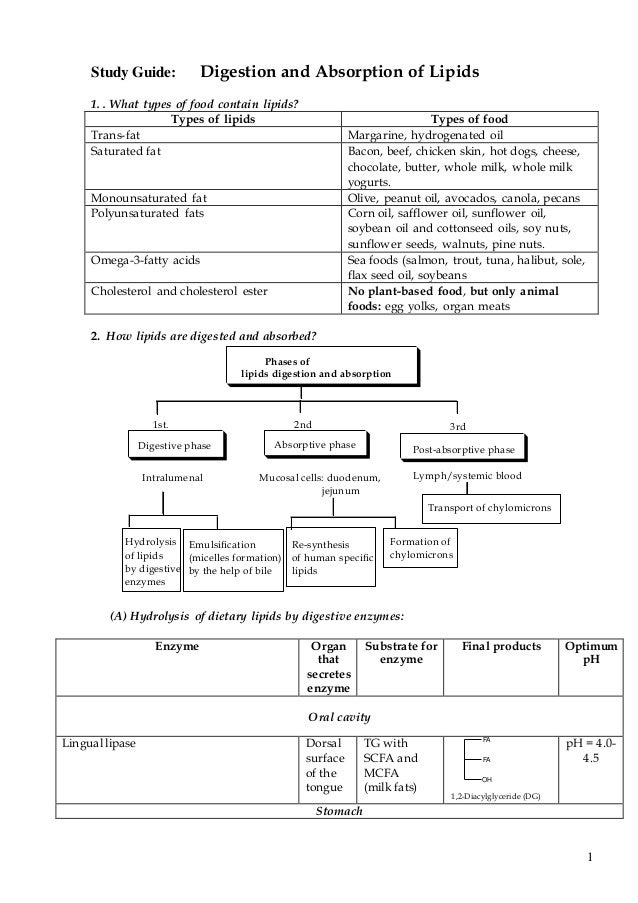42 lipids on food labels
Lipids and the Food Industry - Human Nutrition - University of Hawaiʻi Labeling laws allow foods containing trans fat to be labeled "trans-fat free" if there are fewer than 0.5 grams per serving. This makes it possible to eat too much trans fat when you think you're not eating any at all because it is labeled trans-fat free. Always review the label for trans fat per serving. openoregon.pressbooks.pub › nutritionscienceDigestion and Absorption of Lipids – Nutrition: Science and ... Figure 5.22. Lipid digestion and absorption in the small intestine. Once inside the intestinal cell, short- and medium-chain fatty acids and glycerol can be directly absorbed into the bloodstream, but larger lipids such as long-chain fatty acids, monoglycerides, fat-soluble vitamins, and cholesterol need help with absorption and transport to the bloodstream.
openoregon.pressbooks.pub › unit-5-intro-lipidsIntroduction to Lipids – Nutrition: Science and Everyday ... Figure 5.2 (left): A page from William Clark’s journal of 1805, describing his observations of the euchalon smelt, including its “delicate and luscious” taste.Figure 5.3 (right): Mural panel by Will S. Taylor, entitled “A Tsimshian Family Making Eulachon Butter,” circa 1825, with this description: “The glow of the ember fire is on the girls face as she waits for stones to heat.
Lipids on food labels
Food Labels | CDC - Centers for Disease Control and Prevention If you eat the whole thing, you are eating 8 times the amount of calories, carbs, fat, etc., shown on the label. Total Carbohydrate shows you types of carbs in the food, including sugar and fiber. Choose foods with more fiber, vitamins, and minerals. Choose foods with lower calories, saturated fat, sodium, and added sugars. Avoid trans fat. What to Look For on Nutrition Labels - dummies Trans fatty acid is the newest item to be added to the Nutrition Fact label. Like saturated fat, trans fat is a type of fat. The grams of these fats, and their calories, are already accounted for in the total fat. To figure the number of grams of fat that 30 percent represents, start with your total number of daily calories. Interpreting Total Fat and Types of Fat on Food Labels - Nina Cherie ... Now, at the end of the day, since all high-fat foods tend to drive up calorie counts, it's typically recommended that you limit your intake of total fat to 25-35% of your daily calories. Of this amount, saturated fats and trans fats should comprise less than 7-10% and no more than 1%, respectively. At the very least, following these ...
Lipids on food labels. Food Labels: Fat & Cholesterol | Home & Garden Information Center When comparing food labels, combine the grams (g) of saturated fat and trans fat, then choose the food with the lower combined amount. Look for the lowest % Daily Value for cholesterol, also. Ingredients List: When a food is made with more than one ingredient, an ingredients list is required on the label. Ingredients are listed in order by weight, with the greatest amount listed first and the least amount last. Food Labels -- Nutrition information and misinformation (Page 2 of 3) to be certified by the aha, a product serving must: 1) be low fat (less than or equal to 3 grams), 2) be low saturated fat (less than or equal to 1 gram), 3) be low cholesterol (less than or equal to 20 milligrams), 4) have a sodium value of less than or equal to 480 milligrams for individual foods, 5) contain at least 10 percent of the daily … 5 Understanding Food Labels and Health Claims - Maricopa low salt. Fewer than 140 milligrams of sodium. low cholesterol. Fewer than 20 milligrams cholesterol and 2 grams of saturated fat. lean. FEver than a set amount of grams of fat for that particular cut of meat. high. It contains more than 20% of the nutrient's daily value. good source. The Science Behind Calories and Nutrition Facts Labels These main nutrients are fats ( lipids ), proteins and carbohydrates. Some calories you consume every day should come from each of the three nutrients. About 50 to 60% of your calories should come from carbohydrates, 30% of your calories should come from fat and 12 to 20% of your calories should come from proteins (©2020 Let's Talk Science ...
Should I check the cholesterol on nutrition labels? Major dietary cholesterol contributors — meat, fish, and chicken — often have no label. Having less than 4-6 oz of those per day and less than 2-4 eggs per week will generally keep your cholesterol reasonable. And that's a smart idea anyhow, to leave room for more artery-friendly fruits, veg, whole grains, beans, nuts, seeds, etc." people.umass.edu › ~mcclemen › 581LipidsANALYSIS OF LIPIDS - UMass Government regulations often demand that the amounts of saturated, unsaturated and polyunsaturated lipids, as well as the amount of cholesterol, be specified on food labels. Food Quality. Desirable physical characteristics of foods, such as appearance, flavor, mouthfeel and texture, depend on the type of lipids present. Daily Value on the New Nutrition and Supplement Facts Labels Which Nutrients Are Required to Be Listed on the Nutrition and Supplement Facts Labels? The Nutrition Facts label must list total fat, saturated fat, trans fat, cholesterol, sodium, total... dtc.ucsf.edu › living-with-diabetes › diet-andCounting Sugar Alcohols :: Diabetes Education Online When counting carbohydrates for products made with sugar alcohols, subtract half of the grams of sugar alcohol listed on the food label from the total grams of carbohydrate. Remember that because sugar alcohols are harder for your body to digest, eating too many sugar alcohols may cause digestive complaints like gas, cramping and diarrhea.
› fitness › macronutrientsMacronutrient Calculator - Protein, Fat, Carbohydrate, and Fiber The following calculator facilitates planning a diet. The energy content of a diet is dependent on the quantities of three macronutrients: Proteins, Lipids, and Carbohydrates. Fiber, which consists of undigestible carbohydrates, contributes minimally to the total energy content, but its weight is included in the total carbohydrate content. Lipids Components of Industrialized Food for Nutritional Labelling the different lipid classes contents for nutritional label, comparing procedures: modified AOAC 996.06 method with conventional gravimetric methods. The lipid classes contents were evaluated in industrialized foods in Brazil. Total fat diverged for about 42% of samples, Fatty acidcontents were similar for both methods. The modified AOAC method was lipids on food labels Latest Stories | Echemi Find everything about lipids on food labels you need.You can dig into the news and opinion of lipids on food labels on echemi.com. Understanding Food Labels - Nutrition: Science and Everyday Application ... The FDA uses the following definitions for interpreting the %DV on food labels:4 5%DV or less means the food is low in a nutrient. 10% to 19%DV means the food is a "good source" of a nutrient. 20%DV or greater means the food is high in a nutrient.
Reading the food labels with the lipidomics' help • Lipinutragen This connection is explained by LIPIDOMICS, the now well-known "science of fats" (lipidomics derives from lipids, or fats), which gives us a key to understanding food labels, understanding the value of fats to feel good. Consequently, if we read the type of fats described on the label, we become more aware of which foods we put in the shopping cart.
How to Find Lipids on Food Labels | Healthy Living How to Find Lipids on Food Labels Fats on the Label. Calories are the first item on the nutrition facts label, then the next four lines list total fat,... Track Total Fat. The value for total fat is important because your body depends on getting some fats through your diet. Healthy Fat Information. ...
Food Labels | Nutrition.gov What's New with the Nutrition Facts Label. HHS, Food and Drug Administration. The U.S. Food and Drug Administration (FDA) has updated the Nutrition Facts label on packaged foods and beverages with a fresh design that will make it easier for you to make informed food choices that contribute to lifelong healthy eating habits. What's in a Name?
Food labels and their effects on consumers - The Journalist's Resource In Chile, boxes of Trix have lost their cartoon rabbits and gained black warning labels as part of an effort to limit marketing of unhealthy foods to children. In other countries, packaged foods feature stoplight color coding to indicate their relative nutritional value.. The strategies are aimed at combating the ongoing obesity epidemic. According to data from the Organization for Economic ...
Lipids Components of Industrialized Food for Nutritional Labelling Legal dispositions regarding nutritional facts on food products are been considered. Definitions of lipid contents in the nutrition facts have not been standardised. This paper has the objective to give analytical subsides to evaluate the different lipid classes contents for nutritional label, comparing procedures: modified AOAC 996.06 method with conventional gravimetric methods.
Nutrition Labels 101: What's Required? What's Optional? 5. Trans Fat. Trans fat is the worst of the "bad fats," which is why in 2006 the FDA began requiring it to be listed separately on nutrition labels. Trans fat, like saturated fat, increases LDL cholesterol levels (i.e., "bad" cholesterol) but also lowers HDL cholesterol levels (i.e., "good" cholesterol). So it's a bit of a ...
How to Understand and Use the Nutrition Facts Label | FDA - U.S. Food ... You can use the label to support your personal dietary needs - look for foods that contain more of the nutrients you want to get more of and less of the nutrients you may want to limit. Nutrients...
Nutrition Labelling | Food Information FIC | Food Legislation ... - FSAI The legislation on the provision of food information to consumers allows for an exemption from the mandatory requirement for nutrition labelling for food, including handcrafted food, directly supplied by the manufacturer of small quantities of products to the final consumer or to local retail establishments directly supplying the final consumer.
Learning To Read Labels :: Diabetes Education Online On a nutrition food label, subtract the fiber from the total carbohydrate amount. When you read food labels, the grams of sugar are already included in the total carbohydrate amount, so you do not need to count this sugar amount separately. The grams of sugar listed include both natural sugars, from fruit or milk, and added sugars.
Reading Food Labels (for Parents) - Nemours KidsHealth Food labels must include the ingredients that are in the product, listed in order of how much of the ingredient the food contains. Food-makers are required to clearly state on food labels whether the product contains these common food allergens: peanuts, tree nuts, milk, egg, fish, shellfish, soy, and wheat.
en.wikipedia.org › wiki › FatFat - Wikipedia The most common type of fat, in human diet and most living beings, is a triglyceride, an ester of the triple alcohol glycerol H(–CHOH–) 3 H and three fatty acids. The molecule of a triglyceride can be described as resulting from a condensation reaction (specifically, esterification) between each of glycerol's –OH groups and the HO– part of the carboxyl group HO(O=)C− of each fatty ...
Food labels - NHS Amber means neither high nor low, so you can eat foods with all or mostly amber on the label most of the time. But any red on the label means the food is high in fat, saturated fat, salt or sugars, and these are the foods we should cut down on. Try to eat these foods less often and in small amounts. Ingredients list
Food Labels: Carbohydrates | Home & Garden Information Center On the other hand, choose foods often that contain 5% DV or less of nutrients that you want to limit (e.g., total fat, saturated, fat, trans fat, cholesterol and sodium). Example: On this label the total amount of carbohydrates in one serving (1 packet) is 24 g, or 8% DV. The dietary fiber is 1 g, or 3% DV.
en.wikipedia.org › wiki › Food_energyFood energy - Wikipedia Many governments require food manufacturers to label the energy content of their products, to help consumers control their energy intake. To facilitate evaluation by consumers, food energy values (and other nutritional properties) in package labels or tables are often quoted for convenient amounts of the food, rather than per gram or kilogram; such as in "calories per serving" or "kcal per 100 ...
Lipids Components of Industrialized Food for Nutritional Labelling This paper has the objective to give analytical subsides to evaluate the different lipid classes contents for nutritional label, comparing procedures: modified AOAC 996.06 method with conventional...
How to Read the Nutrition Facts Label on Packaged Foods - WebMD Most of it is in packaged foods and restaurant items. Limit salt to 2,300 milligrams (about 1 teaspoon) daily. If you have high blood pressure, kidney disease, or diabetes, or are African-American...
Interpreting Total Fat and Types of Fat on Food Labels - Nina Cherie ... Now, at the end of the day, since all high-fat foods tend to drive up calorie counts, it's typically recommended that you limit your intake of total fat to 25-35% of your daily calories. Of this amount, saturated fats and trans fats should comprise less than 7-10% and no more than 1%, respectively. At the very least, following these ...















Post a Comment for "42 lipids on food labels"